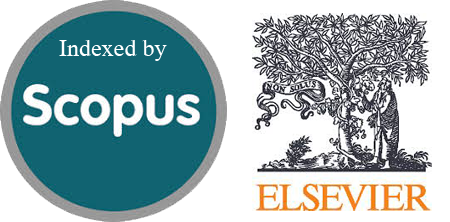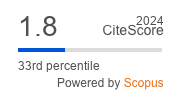A New Framework for Dynamic Educational Marketing Segmentation in Student Recruitment: Optimizing Fuzzy C-Means with Metaheuristic Techniques
Abstract
An effective educational marketing strategy requires accurate school segmentation to enhance new student recruitment. Traditional segmentation methods such as K-means are often used, but they have limitations in capturing the flexibility of school characteristics. Fuzzy C-Means (FCM) offers a more adaptive approach by allowing each school to simultaneously have a degree of membership in several clusters. However, the performance of FCM highly depends on determining parameters such as the number of clusters (k) and the level of fuzziness (m), which are not always optimal when determined manually. This study develops a new framework for dynamic educational marketing segmentation in student recruitment by optimizing FCM using three metaheuristic techniques: Genetic Algorithm (GA), Particle Swarm Optimization (PSO), and Differential Evolution (DE). Performance was evaluated using the Fuzzy Silhouette Index (FSI). The experimental results showed that DE yielded the best results with the highest FSI value (0.8023), producing eight main clusters based on the Recency, Frequency, and Monetary (RFM) model. Based on the clustering results, a personalized and adaptive marketing strategy was designed to enhance the effectiveness of student recruitment. The proposed framework enhances segmentation accuracy and supports the implementation of dynamic data-driven marketing in the context of higher education. This study also opens new directions for educational data mining research and machine-learning-based marketing strategies.
Downloads
References
R. D. Dana, C. L. Rohmat, and A. R. Rinaldi, “Strategi Marketing Penerimaan Mahasiswa Baru Menggunakan Machine Learning dengan Teknik Clustering,” Jurnal Informatika: Jurnal Pengembangan IT, vol. 4, no. 2–2, pp. 201–204, Dec. 2019, doi: 10.30591/JPIT.V4I2-2.1879.
A. N. Alifah, R. P. Permata, I. M. W. A. Sanjaya, P. Arismawati, and W. A. Prastyabudi, “Data-Driven Insights into High School Market Segmentation Using Multidimensional Clustering Approaches,” 2024 Beyond Technology Summit on Informatics International Conference, BTS-I2C 2024, pp. 47–52, 2024, doi: 10.1109/BTS-I2C63534.2024.10941845.
Ernawati, S. S. K. Baharin, and F. Kasmin, “Target Market Determination for Information Distribution and Student Recruitment Using an Extended RFM Model with Spatial Analysis,” Journal of Distribution Science, vol. 20, no. 6, pp. 1–10, 2022, doi: 10.15722/JDS.20.06.202206.1.
W. A. Prastyabudi, A. N. Alifah, and A. Nurdin, “Segmenting the Higher Education Market: An Analysis of Admissions Data Using K-Means Clustering,” Procedia Comput Sci, vol. 234, pp. 96–105, Jan. 2024, doi: 10.1016/J.PROCS.2024.02.156.
A. Diana, A. Ariesta, A. Wibowo, A. B. Risaychi, and C. Author, “New Student Clusterization Based On New Student Admission Using Data Mining Method,” Jurnal Pilar Nusa Mandiri, vol. 19, no. 1, pp. 1–10, Mar. 2023, doi: 10.33480/PILAR.V19I1.4089.
D. Susilowati et al., “Segmentasi Lokasi Promosi Penerimaan Mahasiswa Baru Menggunakan Metode RFM dan K-Means Clustering,” MATRIK : Jurnal Manajemen, Teknik Informatika dan Rekayasa Komputer, vol. 21, no. 2, pp. 275–282, Mar. 2022, doi: 10.30812/MATRIK.V21I2.1542.
O. N. Akande, H. B. Akande, E. O. Asani, and B. T. Dautare, “Customer Segmentation through RFM Analysis and K-means Clustering: Leveraging Data-Driven Insights for Effective Marketing Strategy,” International Conference on Science, Engineering and Business for Driving Sustainable Development Goals, SEB4SDG 2024, 2024, doi: 10.1109/SEB4SDG60871.2024.10630052.
S. Safouan, K. El Moutaouakil, and A. M. Patriciu, “Fractional Derivative to Symmetrically Extend the Memory of Fuzzy C-Means,” Symmetry 2024, Vol. 16, Page 1353, vol. 16, no. 10, p. 1353, Oct. 2024, doi: 10.3390/SYM16101353.
A. Qtaish, M. Braik, D. Albashish, M. T. Alshammari, A. Alreshidi, and E. J. Alreshidi, “Optimization of K-means clustering method using hybrid capuchin search algorithm,” Journal of Supercomputing, vol. 80, no. 2, pp. 1728–1787, Jan. 2024, doi: 10.1007/S11227-023-05540-5/METRICS.
S. Sobantu and O. E. Isafiade, “Cascaded RFM-Based Fuzzy Clustering Model for Dynamic Customer Segmentation in the Retail Sector,” Communications in Computer and Information Science, vol. 2326 CCIS, pp. 53–73, 2025, doi: 10.1007/978-3-031-78255-8_4.
K. Zhou and S. Yang, “Effect of cluster size distribution on clustering: a comparative study of k-means and fuzzy c-means clustering,” Pattern Analysis and Applications, vol. 23, no. 1, pp. 455–466, Feb. 2020, doi: 10.1007/S10044-019-00783-6/METRICS.
S. Hidayat, R. Rismayati, M. Tajuddin, N. Luh, and P. Merawati, “Segmentation of university customers loyalty based on RFM analysis using fuzzy c-means clustering,” Jurnal Teknologi dan Sistem Komputer, vol. 8, no. 2, pp. 133–139, Apr. 2020, doi: 10.14710/JTSISKOM.8.2.2020.133-139.
M. Sivaguru and M. Punniyamoorthy, “Dynamic fuzzy clustering algorithm using cumulative cost curve with application to dynamic customer segmentation,” Int J Bus Inf Syst, vol. 46, no. 1, pp. 73–106, 2024, doi: 10.1504/IJBIS.2024.138551.
Y. Li, J. Gou, and Z. Fan, “Educational data mining for students’ performance based on fuzzy C-means clustering,” The Journal of Engineering, vol. 2019, no. 11, pp. 8245–8250, Nov. 2019, doi: 10.1049/JOE.2019.0938.
I. Singh, S. Sabitha, T. Choudhury, A. Aggarwal, and B. K. Dewangan, “Mapping Student Performance With Employment Using Fuzzy C-Means,” https://services.igi-global.com/resolvedoi/resolve.aspx?doi=10.4018/IJISMD.2020100103, vol. 11, no. 4, pp. 36–52, Jan. 1AD, doi: 10.4018/IJISMD.2020100103.
B. A. Muhammad et al., “A Fuzzy C-means Algorithm to Detect Learning Styles in Online Learning Environment,” Journal of Networking and Network Applications, vol. 4, no. 1, pp. 39–47, May 2024, doi: 10.33969/J-NANA.2024.040105.
K. B. Utomo, P. Arbain, and Suminto, “Application of fuzzy C-means algorithm for basic school clustering in Samarinda city based on minimum educational service standard indicators,” IOP Conf Ser Mater Sci Eng, vol. 885, no. 1, p. 012002, Jul. 2020, doi: 10.1088/1757-899X/885/1/012002.
S. Deng, “Clustering with Fuzzy C-means and Common Challenges,” J Phys Conf Ser, vol. 1453, no. 1, p. 012137, Jan. 2020, doi: 10.1088/1742-6596/1453/1/012137.
Y. Chen, S. Zhou, X. Zhang, D. Li, and C. Fu, “Improved fuzzy c-means clustering by varying the fuzziness parameter,” Pattern Recognit Lett, vol. 157, pp. 60–66, May 2022, doi: 10.1016/J.PATREC.2022.03.017.
H. Zhang and S. L. Huang, “Improved fuzzy C-means clustering algorithm based on fuzzy particle swarm optimization for solving data clustering problems,” Math Comput Simul, vol. 233, pp. 311–329, Jul. 2025, doi: 10.1016/J.MATCOM.2025.02.012.
F. Belhabib, M. Benslimane, and K. El Moutaouakil, “Advanced Big Data Analytics: Integrating Fuzzy C-Means, Encoder-Decoder CNNs, and Genetic Algorithms for Efficient Clustering and Classification,” Statistics, Optimization & Information Computing, vol. 13, no. 1, pp. 222–247, Jan. 2025, doi: 10.19139/SOIC-2310-5070-1978.
S. Burada, B. E. Manjunathswamy, and M. Sunil Kumar, “Early detection of melanoma skin cancer: A hybrid approach using fuzzy C-means clustering and differential evolution-based convolutional neural network,” Measurement: Sensors, vol. 33, p. 101168, Jun. 2024, doi: 10.1016/J.MEASEN.2024.101168.
R. J. Kuo, C. C. Hsu, T. P. Q. Nguyen, and C. Y. Tsai, “Hybrid multi-objective metaheuristic and possibilistic intuitionistic fuzzy c-means algorithms for cluster analysis,” Soft Computing 2023 28:2, vol. 28, no. 2, pp. 991–1008, Nov. 2023, doi: 10.1007/S00500-023-09367-3.
K. Bhalla and A. Gosain, “Performance Analysis of Hybridized Fuzzy Clustering Algorithms Using Metaheuristic Algorithms,” Lecture Notes in Networks and Systems, vol. 680 LNNS, pp. 445–461, 2023, doi: 10.1007/978-981-99-2602-2_34.
A. Banerjee and I. Abu-Mahfouz, “A Novel Adaptive FCM with Cooperative Multi-Population Differential Evolution Optimization,” Algorithms 2022, Vol. 15, Page 380, vol. 15, no. 10, p. 380, Oct. 2022, doi: 10.3390/A15100380.
H. Wickham, R. François, L. Henry, K. Müller, and D. Vaughan, “dplyr: A Grammar of Data Manipulation,” CRAN: Contributed Packages, Jan. 2014, doi: 10.32614/CRAN.PACKAGE.DPLYR.
H. Wickham, “reshape2: Flexibly Reshape Data: A Reboot of the Reshape Package,” CRAN: Contributed Packages, Apr. 2020, doi: 10.32614/CRAN.PACKAGE.RESHAPE2.
R. C. Blattberg, B.-D. Kim, and S. A. Neslin, “RFM Analysis,” Feb. 2024, doi: 10.1007/978-0-387-72579-6_12.
J. C. Bezdek, R. Ehrlich, and W. Full, “FCM: The fuzzy c-means clustering algorithm,” Comput Geosci, vol. 10, no. 2–3, pp. 191–203, Jan. 1984, doi: 10.1016/0098-3004(84)90020-7.
D. Meyer, E. Dimitriadou, K. Hornik, A. Weingessel, and F. Leisch, “Misc Functions of the Department of Statistics, Probability Theory Group (Formerly: E1071), TU Wien [R package e1071 version 1.7-16],” CRAN: Contributed Packages, Sep. 2024, doi: 10.32614/CRAN.PACKAGE.E1071.
B. Alhijawi and A. Awajan, “Genetic algorithms: theory, genetic operators, solutions, and applications,” Evol Intell, vol. 17, no. 3, pp. 1245–1256, Jun. 2024, doi: 10.1007/S12065-023-00822-6/METRICS.
L. Scrucca, “GA: A package for genetic algorithms in R,” J Stat Softw, vol. 53, no. 4, pp. 1–37, 2024, doi: 10.18637/JSS.V053.I04.
L. Abualigah et al., “Particle swarm optimization algorithm: review and applications,” Metaheuristic Optimization Algorithms: Optimizers, Analysis, and Applications, pp. 1–14, Jan. 2024, doi: 10.1016/B978-0-443-13925-3.00019-4.
C. Bendtsen, “pso: Particle Swarm Optimization,” CRAN: Contributed Packages, Sep. 2022, doi: 10.32614/CRAN.PACKAGE.PSO.
K. M. Mullen, D. Ardia, D. L. Gil, D. Windover, and J. Cline, “DEoptim: An R package for global optimization by differential evolution,” J Stat Softw, vol. 40, no. 6, pp. 1–26, 2011, doi: 10.18637/JSS.V040.I06.
R. J. G. B. Campello and E. R. Hruschka, “A fuzzy extension of the silhouette width criterion for cluster analysis,” Fuzzy Sets Syst, vol. 157, no. 21, pp. 2858–2875, Nov. 2006, doi: 10.1016/J.FSS.2006.07.006.
P. Giordani, M. B. Ferraro, and A. Serafini, “fclust: Fuzzy Clustering,” CRAN: Contributed Packages, Nov. 2022, doi: 10.32614/CRAN.PACKAGE.FCLUST.
A. Supriyanto et al., “Partnership Quality, Student’s Satisfaction, and Loyalty: A Study at Higher Education Legal Entities in Indonesia,” Open Education Studies, vol. 6, no. 1, Jan. 2024, doi: 10.1515/EDU-2024-0035/ASSET/GRAPHIC/J_EDU-2024-0035_FIG_002.JPG.
P. Shukla et al., “The Role of Emotions in Consumer Brand Loyalty: A Neuromarketing Approach,” International Journal of Tourism and Hospitality in Asia Pasific, vol. 7, no. 1, pp. 104–116, Feb. 2024, doi: 10.32535/IJTHAP.V7I1.2901.
C. Prentice, X. Wang, and S. M. C. Loureiro, “The influence of brand experience and service quality on customer engagement,” Journal of Retailing and Consumer Services, vol. 50, pp. 50–59, Sep. 2019, doi: 10.1016/J.JRETCONSER.2019.04.020.
S. P. John and R. De Villiers, “Factors affecting the success of marketing in higher education: a relationship marketing perspective,” Journal of Marketing for Higher Education, Jul. 2024, doi: 10.1080/08841241.2022.2116741.
N. Behare et al., “Data-Driven Insights: The Power of Genetic Information in Precision Marketing,” https://services.igi-global.com/resolvedoi/resolve.aspx?doi=10.4018/979-8-3693-2367-0.ch003, pp. 41–65, Jan. 1AD, doi: 10.4018/979-8-3693-2367-0.CH003.
Copyright (c) 2025 Jurnal RESTI (Rekayasa Sistem dan Teknologi Informasi)

This work is licensed under a Creative Commons Attribution 4.0 International License.
Copyright in each article belongs to the author
- The author acknowledges that the RESTI Journal (System Engineering and Information Technology) is the first publisher to publish with a license Creative Commons Attribution 4.0 International License.
- Authors can enter writing separately, arrange the non-exclusive distribution of manuscripts that have been published in this journal into other versions (eg sent to the author's institutional repository, publication in a book, etc.), by acknowledging that the manuscript has been published for the first time in the RESTI (Rekayasa Sistem dan Teknologi Informasi) journal ;








